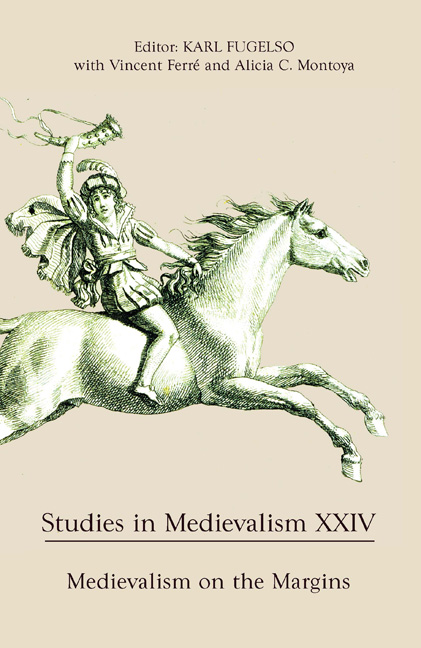Book contents
- Frontmatter
- Acknowledgments
- Contents
- List of Illustrations
- Volume XXIV 2015
- Editorial Note
- I Medievalism on the Margins: Some Perspective(s)
- 1 Medievalism in the Margins: Paratexts and the Packaging of Medieval French Literature
- 2 Medievalism Studies and the Subject of Religion
- 3 Pop Medievalism
- 4 Ecomedievalism: Applying Ecotheory to Medievalism and Neomedievalism
- 5 Whiteness and Time: The Once, Present, and Future Race
- 6 A Desire for Origins: The Marginal Robin Hood of the Later Ballads
- 7 Women, Queerness, and Massive Chalice: Medievalism in Participatory Culture
- 8 “Constant inward looking,” Medieval Devotional Literature, and the Concordium-Fruitlands Library
- II Trans-Atlantic Medievalism(s)
- III Other Interpretations
- Contributors
5 - Whiteness and Time: The Once, Present, and Future Race
from I - Medievalism on the Margins: Some Perspective(s)
Published online by Cambridge University Press: 05 December 2015
- Frontmatter
- Acknowledgments
- Contents
- List of Illustrations
- Volume XXIV 2015
- Editorial Note
- I Medievalism on the Margins: Some Perspective(s)
- 1 Medievalism in the Margins: Paratexts and the Packaging of Medieval French Literature
- 2 Medievalism Studies and the Subject of Religion
- 3 Pop Medievalism
- 4 Ecomedievalism: Applying Ecotheory to Medievalism and Neomedievalism
- 5 Whiteness and Time: The Once, Present, and Future Race
- 6 A Desire for Origins: The Marginal Robin Hood of the Later Ballads
- 7 Women, Queerness, and Massive Chalice: Medievalism in Participatory Culture
- 8 “Constant inward looking,” Medieval Devotional Literature, and the Concordium-Fruitlands Library
- II Trans-Atlantic Medievalism(s)
- III Other Interpretations
- Contributors
Summary
Nestled among the concrete, glass, and steel skyscrapers in the central business district of Perth, Western Australia, the mock Tudor frontage of “Ye London Court” is, at first sight, a curious landmark. Completed in 1937, the cobbled pedestrian mall compresses history, time, and place. A plaque at the entrance commemorates 1997 as both the 60th anniversary of the space and the 600th anniversary of the election of Dick Whittington as Lord Mayor of London. “Ye London Court” is just one of the many examples littered throughout the Australian landscape of medievalism being employed to foster connections between the antipodes and the old imperial center. Along the walls portraits of Henry VIII and Elizabeth I overlook gothic-lettered shop-signs advertising everything from nail salons to lawyers’ offices, and the “Purely Australian Clothing Co.” The medieval(-ish) font overrides all other symbols, except the trade-marked brand name of the national postal service. The space as a whole, and its individual elements, are wide open to interpretation by scholars of medievalism. In its present form as a tourist curiosity, “Ye London Court” sees romantic nostalgic medievalism and neomedievalisms bleed into each other. One of the most incongruous of the advertising signs reads “Aboriginal Art Australian Gifts” (Fig. 1). It is relatively easily parsed: the gothic lettering takes possession of indigenous culture, even as the shop it advertises fragments it into commercial products, to be sold, bought, and owned by passing tourists. Australia, a Western nation in another hemisphere from England's, provides a small piece of Europe with a tiny piece of local culture embedded within it. Neomedievalism serves commercial neocolonialism. This reading is typical, in some if not all ways, of the scholarship of medievalism in that it considers the cultural context of a manifestation of medievalism. But in doing so, it disengages the word “Aboriginal” from its history as a specifically racial – and not just cultural – category.
- Type
- Chapter
- Information
- Studies in Medievalism XXIVMedievalism on the Margins, pp. 39 - 50Publisher: Boydell & BrewerPrint publication year: 2015

